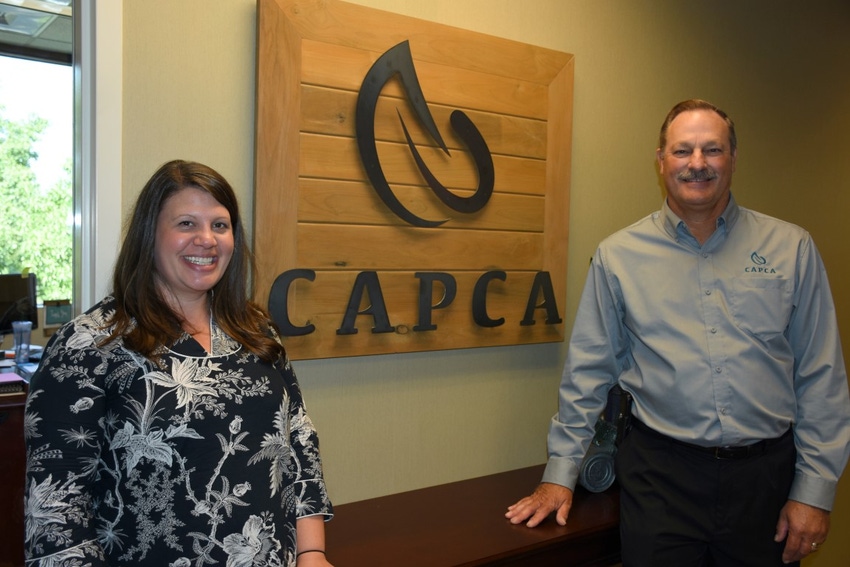September 18, 2017

The California Association of Pest Control Advisers this fall is launching a new initiative called ‘CAPCA, at the Center of Plant Health’ to better meet the needs of future generations of pest control advisers and engage more in the growing number of divisive issues facing agriculture.
“We are excited to kick off the new CAPCA brand identity,” says CAPCA President and Chief Executive Officer Ruthann Anderson.
Anderson and CAPCA Board Chair Rick Wescott met with Western Farm Press in September at CAPCA headquarters in Sacramento to discuss the group’s new makeover and their strategies to build a stronger CAPCA organization.
Why change?
Why the new branding? Anderson says it’s largely tied to results of the 2015 CAPCA membership survey. Among the results was the realization that the California pest control industry is facing a mass retirement of PCAs. The survey revealed:
1 - PCA retirements could increase 30 percent by 2020; and
2 – About 50 percent of current PCAs could take down their crop consulting ‘shingle’ and retire by 2025.
These findings and others led Anderson to make changes at CAPCA.
“Based on PCA’s retirement plans, there will be a huge amount of institutional knowledge leaving the field” which concerns Anderson. “The challenge is to get as much of their knowledge and experience in the hands and minds of new PCAs before the veteran PCAs retire.”
This understanding should include a professional knowledge of plant protection to gain state licensing and in the end achieve higher yields for growers.
Next gen PCAs
Anderson says working with newer PCAs will both be a rewarding and learning process as many are more connected by smartphones and tablets with strong ties to social media. CAPCA will have a larger presence on Facebook and Twitter so PCAs can better connect and share pro-agriculture messaging.
“I see a strong desire and willingness of new PCAs to become engaged in telling their story as it fits into the larger story of agriculture.”
The CAPCA prexy wants PCAs involved in their local CAPCA chapter; 16 are located across the Golden State. This will enable them to bond and strengthen their PCA craft.
In recent years, CAPCA has expanded more into turf and ornamental crops, says Wescott, a Bayer CropScience technical sales representative based at Visalia, Calif. About 10 percent of CAPCA PCA members are in the turf-ornamental sector.
New CAPCA initiatives and branding will be discussed during the 2017 ‘Guardians of the Green’ CAPCA Conference, Oct. 15-17 at Reno, Nev.
CAPCA has about 3,200 members across the Golden State, including almost 3,000 of the state’s 4,000 licensed PCAs (about 75 percent), plus 100 each of corporate and student/ associate members.
Feet first
Another key part of CAPCA’s new forward strategy is a higher association involvement in agricultural issues indirectly impacting PCAs, including water, regulatory and legislative concerns.
“This is CAPCA’s future,” Wescott explains. “I see us working with other agricultural groups to make the industry better and becoming actively involved with legislation and other issues which impact laws and regulations.”
CAPCA, the state’s largest PCA organization, will partner with the Western Plant Health Association (WPHA), California Farm Bureau, Western Growers, Crop Life America, and California Citrus Mutual (CCM) on mutual interests.
As an investment in these partnerships, CAPCA this year hired Adam Barsanti as the group’s outreach relations manager to work with lawmakers, regulators, and allied farm groups.
Collaboration
For example, the association will collaborate closely with WPHA and CropLife America on chemical issues, including work to keep crop protection tools, including neonicotinoids and pyrethroids, in growers’ and PCAs’ toolboxes.
In mid-September, the California Department of Pesticide Regulation held open hearings on the insecticide chlorpyrifos. Anderson made phone calls to county agriculture commissioners to discuss how new suggested permit conditions on chlorpyrifos use could impact urban and rural applications.
Go team go!
In essence, CAPCA Forward is akin to a football team with both offense and defense approaches – on the offense to help PCAs provide good options to growers and on the defense, says Wescott, against some environmental groups who want to remove many safe farm chemicals from agriculture.
“Farm chemical companies spend millions of dollars to bring a chemical to market, including huge dollars to determine whether the produce is safe,” says Wescott. “We have tons of evidence which prove these products are safe.”
Wescott, a 34-year Bayer veteran, grew up on a Colusa, Calif. farm, and today grows 80 acres of Navel oranges and Satsuma mandarins on his Visalia farm. He’s tired of scare tactics used to discredit genetically-modified organisms (GMOs) and other technology while not weighing the science supporting it.
“Some environmental groups are using emotion to have a large influence on legislation.”
In another CAPCA change, the association hired George Soares as the principle lobbyist from Kohn, Soares, and Conway, LLP.
Enhanced member benefits
Also part of CAPCA’s rebrand is its revamped website plus the newer Applicator Alerts newsletter. CAPCA has a new logo illustrating a leaf in a hand. They also added a new Spring Conference this year which included a field day at a local vineyard.
Even with these changes, Anderson acknowledges that CAPCA’s basic vision remains the same as when founding leader Stanley Strew started CAPCA at his home in 1975.
“CAPCA’s mission is to be a leader and voice for the licensee and to serve its membership – the PCA,” Anderson says. “The PCA is an integral part of agriculture. They are ‘plant doctors’ and CAPCA is here to represent them.”
You May Also Like




